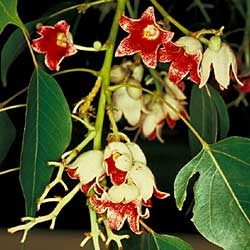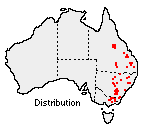Brachychiton populneus
 |
 |
Kurrajong
Brachychiton populneus (Schott & Endl.) R.Br.
Brachychiton populneus, commonly called Kurrajong, is a native to eastern Australia with much value in cultivation. Plants are tolerant of dry conditions, easy to propagate and have many interesting features.
 Naturally
distributed from north-eastern Victoria to Townsville and from the coast through
to the semi-arid inland, B. populneus inhabits various well-drained soil
types, often occurring amongst rocky outcrops of granite or limestone and also
thriving on deeper soils in some areas.
Naturally
distributed from north-eastern Victoria to Townsville and from the coast through
to the semi-arid inland, B. populneus inhabits various well-drained soil
types, often occurring amongst rocky outcrops of granite or limestone and also
thriving on deeper soils in some areas.
The species Brachychiton populneus has two subspecies that differ in adult leaf shape. Subspecies trilobus has a more northerly and inland distribution and displays leaves with 3, sometimes 5, narrow lobes. The adult leaves of subspecies populneus have reduced side lobes and appear more like those of poplars (Populus species).
Flowers are bell-shaped and whitish in colour with the inner flower tube streaked purple-brown. Cultivated hybrids involving B. populneus display pink or red flowers. Seeds are borne within woody, boat-shaped fruit 1-7 cm long and are surrounded by fine hairs that can cause skin and eye irritation.
Juvenile plants, which display attractive lobed leaves and swollen taproots, make good pot-plants tolerant of dry and pot-bound conditions that respond well to pruning.
Trees are typically stout with glossy-green foliage and are widely used as street trees in Australia and overseas. Native populations on agricultural land are often retained to provide dense shade and drought fodder. Leaves lopped from branches are nutritious and desirable to stock, however consumption of the fruit may cause illness. The deep rooting trees have minimal impacts on cropping and also support honey production.
Ground-up seeds can be brewed into a coffee substitute or added to bread. The swollen, carrot-like taproot is a nutritious and agreeable vegetable and the gum exudate is also edible. Kurrajong fibre taken from the stem has been used in twine and netting manufacture.
Propagation is from seed or cutting. Seeds are readily germinated and immersion in warm-hot water then soaking for 12 hours enhances success. Care must be taken to avoid the irritating hairs surrounding the seeds. Cuttings from plants with desirable characteristics may be grafted onto seedling rootstock. Plants to 2 m respond well to transplantation if the swollen taproot is conserved and the branches trimmed to reduce water loss.
While sapling growth is often very slow, great improvements are possible through soil cultivation, watering and care. Plants have numerous pests and diseases but show resilience to defoliation. Internal infections are best avoided by application of anti-fungal treatments to open wounds. It should also be noted that kurrajongs may cause nuisance from their large woody fruit, deep roots that clog drains and potential for escape into native vegetation (e.g. near Perth). Other Brachychiton species in cultivation include B. acerifolius (Flame Tree), B. discolor (Lacebark), B. rupestris (Bottle Tree) and B. gregorii (Desert Kurrajong).
Text by Tom Taverner (2002 Botanical Intern)
Name meaning: Brachychiton populneusBrachychiton - from two Greek words, meaning 'short', and 'tunic', an allusion to the bristles surrounding the seed in the fruit; populneus - from the Latin 'poplar-like'; the leaves resemble those of Populus species. |
![An Australian Government Initiative [logo]](/images/austgovt_brown_90px.gif)

